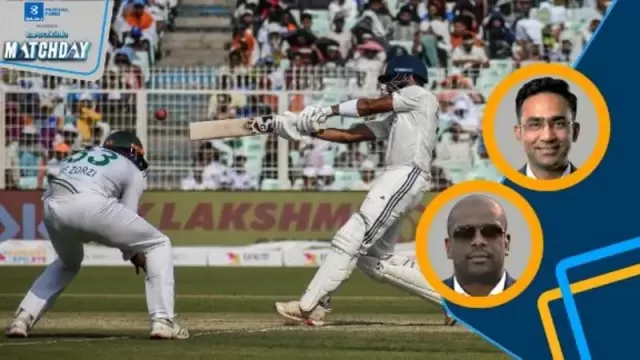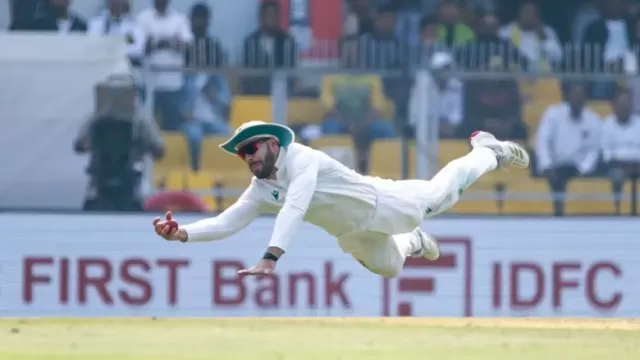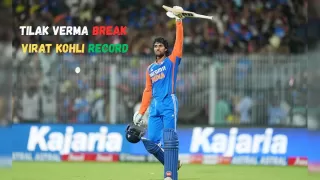Jansen Destroys India as South Africa Eye Series Sweep

Marco Jansen produced a spellbinding display of fast bowling that left India reeling on the third day of the second Test in Guwahati. On a pitch that offered little obvious assistance for pace, Jansen's aggressive short-pitched assault and precise use of the bouncer transformed the contest, ripping through a young Indian lineup and snuffing out hopes of a comeback. By the close of play South Africa, having posted a formidable 489 in their first innings, held a commanding lead and began to dream of a rare series win on foreign soil.
India’s batting displayed brief flashes of resistance — notably from Yashasvi Jaiswal and Washington Sundar — but the overall performance was undermined by a rapid middle-order collapse once Jansen seized control. The nature of the dismissals, many induced by hostile short balls and excellent catches in the deep, illustrated a contest decided more by raw pace and intimidation than by subtle pitch quirks. For South Africa, it was a day of near-perfect execution; for India, a reminder of how brittle their batting can look against relentless aggression.
When the dust settled, the scoreboard bore testimony to a dominant South African effort: 489 and 26 for 0, leading India 201 (Jaiswal 58, Washington 48) by 314 runs. Jansen finished with a devastating 6 for 48, while Simon Harmer and other visitors contributed crucial support. The match narrative shifted firmly in favour of the tourists, who now occupy the psychological and statistical advantage with an unassailable 1-0 series edge.
Jansen’s Short-Ball Brilliance Turns the Tide

Jansen’s impact began in earnest when he introduced a barrage of well-directed bouncers that repeatedly dislodged defensive stances and forced hurried shots. The raw velocity coupled with a towering release point made his short deliveries particularly hard to negotiate; several batsmen were beaten for height and timing, producing edges and mistimed pull shots. In a remarkable sequence, Jansen dismissed Dhruv Jurel, Ravindra Jadeja, Nitish Kumar Reddy and Jasprit Bumrah with short-pitched blows that exploited even minor technical flaws.
Statistics from the innings painted a striking picture: nobody has recorded as many wickets with bouncers in a single innings in India since ball-by-ball records began. Beyond the numbers, it was the psychological effect — the way a single over could sap confidence and reorder the batting side's approach — that made Jansen’s spell so devastating. His athleticism in the field, including a breath-taking catch, underlined a full-spectrum contribution that echoed historical great all-round days in India.
Bright Spots: Jaiswal and Washington Fight Back

Amid the carnage, Yashasvi Jaiswal and Washington Sundar offered intermittent resistance. Jaiswal’s 58 stood out as the innings’ lone half-century, crafted with controlled strokeplay and selective aggression. Washington’s 48, coming from the lower middle order, was notable for its grit; he and Kuldeep Yadav shared an extended partnership that showcased patience and shot selection under pressure.
Their stand of nearly 35 overs illustrated that once the initial moisture and seam movement abated, India’s batters were capable of steady work. It was a reminder that not all hope was extinguished — had more batsmen matched that temperament, the match might have evolved differently. Yet ultimately, their efforts were insufficient to counter the tide unleashed by Jansen and the disciplined South African attack.
Turning Points: Early Luck and Panic in the Line-up
South Africa benefited from moments of fortune and a visible loss of composure among younger Indian batters. A few deliveries that unexpectedly turned or bounced compounded the challenge, but much of the damage stemmed from mounting pressure and rushed decision-making. The transformation between India’s solid start at 65 without loss and the collapse that followed highlighted how momentum can shift swiftly under sustained assault.
India’s nos. 3 and 4, inexperienced in terms of centuries and aggregate runs, looked particularly susceptible when faced with hostile short-pitched bowling. The quick succession of wickets before tea, including dismissals off two balls that did more than usual, underlined how the match tilted in a short window — a phase where Jansen’s pace and the visitors’ fielding brilliance combined to decisive effect.
Fielding Moments and Memorable Catches
The innings also featured a string of stunning catches that amplified the bowlers’ efforts. Aiden Markram’s athletic take to remove Nitish Kumar Reddy and Rickelton’s sharp work in the cordon reflected South Africa’s all-round excellence. Jansen’s catch to dismiss Jaiswal was a highlight — a diving, forward-reaching effort that demonstrated impeccable judgment and reflexes.
These moments had both immediate scoreboard impact and a morale effect: each athletic dismissal seemed to sap India’s resolve a little more, while bolstering the visitors’ confidence. In Test cricket, such fielding interventions can be as match-defining as any bowling spell, and on this day they were integral to South Africa’s ascendancy.
Tactical Shifts: Pace, Bounce and Psychological Pressure
Jansen’s ability to bowl a metre fuller than the home pacers while still producing bouncers put India under constant discomfort. He consistently brought the short ball into play even when the pitch had lost its initial sting, preventing batters from settling. The tactical decision to attack with bouncers and persist with aggressive lines paid rich dividends.
Even when the ball was older and the conditions less obviously helpful, Jansen maintained aggression — a tactic that forced India onto the back foot. The visitors combined pace with disciplined lines and a willingness to challenge the batsmen physically, a blueprint that proved hard for India to counter in crucial moments.
Post-Tea Session: Attempts at Counterattack Die Quickly
After tea, there were glimpses of resistance as captain Rishabh Pant attempted a counterattack, charging down the track at Jansen in an effort to wrest control. The counter-attack, however, yielded only an edge to the keeper. Subsequent dismissals — Reddy and Jadeja falling to vicious short deliveries — extinguished further hopes of a revival.
India’s intent was visible but the execution faltered; the team pressed and prodded but could not convert aggression into substantial partnerships. That failure left the hosts vulnerable, and with time running out in the match, the visitors were perfectly placed to press for a decisive result.
Looking Ahead: South Africa’s Momentum and India’s Recovery Tasks
With South Africa 314 runs ahead and in an unassailable position psychologically, they need only a few more sessions to convert their advantage into a match-winning posture. For India, the task is clear: repair the batting unit’s technique against short-pitched bowling, build resilience among the middle order, and find a clearer plan to blunt the impact of aggressive pace bowlers like Jansen.
The series now swings in favour of the tourists, who will look to consolidate and chase an elusive series win on Indian soil. India, meanwhile, must regroup quickly if they are to stave off a second home series defeat within twelve months. The coming sessions will test both teams’ tactical depth and mental fortitude.
Conclusion: A Day Dominated by Pace and Precision
November 24 will be remembered as the day Marco Jansen turned a contest with hostile short-ball mastery and relentless intent. His six-wicket haul and earlier batting heroics have put South Africa firmly on course for a famous victory. For Indian cricket, it is a sobering lesson in the raw potency of pace and the thin margin for error at the highest level.
As the match progresses, the balance of power lies with the visitors. Test cricket often pivots on days like this — when a bowler seizes control and changes the narrative — and on this occasion, Jansen’s spell did exactly that.
Also Read: Lakshya Sen Wins Epic 85-Minute Thriller to Reach Final
Disclaimer
Possible11 is a sports news platform that provides live scores, player statistics, and tournament updates for informational and educational purposes only. We comply with the Online Gaming Bill, 2025 (India) and do not promote or engage with fantasy sports, betting, or real-money gaming platforms. All content is intended solely to enhance the sports experience. Possible11 is not affiliated with any fantasy or gambling applications and is not responsible for any financial gains or losses incurred on external platforms.












Give Your Feedback